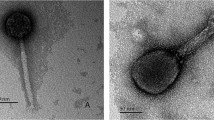Abstract
Bacillus subtilis phages 41c and SPPI were compared. They were identical in their morphologies, their patterns of infectivity, and the buoyant densities of native and denatured DNA. However, differences in plaque morphologies, protein subunit molecular weights, and cleavage patterns generated by treatment of each DNA with restriction endonucleases indicated that phage 41c was not identical to SPPI. It is proposed that phage 41c be considered a separate member of the group-5B. subtilis phages, a group currently comprising only phage SPPI.
Similar content being viewed by others
Literature Cited
Adams MH (1959) Bacteriophages. New York: Interscience
Altman E, Altman RK, Garrett JM, Grimaila RJ, Young R (1983) S gene product: identification and membrane localization of a lysis control protein. J Bacteriol 155:1130–1137
Davis RW, Botstein D, Roth JR (1980) Advanced bacterial genetics, Cold Spring Harbor NY: Cold Spring Harbor Laboratory
Esche H, Schweiger M, Trautner TA (1975) Gene expression of bacteriophage SPPI. I. Phage directed protein synthesis. Mol Gen Genet 142:45–55
Green DM, Laman D (1972) Organization of gene function inBacillus subtilis bacteriophage SP82G. J Virol 9:1033–1046
Hemphill HE, Whiteley HR (1975) Bacteriophages ofBacillus subtilis. Bacteriol Rev 39:257–315
Jacobson ED, Landman OE (1975) Interaction of protoplasts, L forms, and bacilli ofBacillus subtilis with 12 strains of bacteriophage. J Bacteriol 124:445–458
Landry EF, Zsigray RM (1980) Effects of calcium on the lytic cycle ofBacillus subtilis phage 41c. J Gen Virol 51:125–135
Mandel JD, Hershey AD (1960) A fractionating column for analysis of nucleic acids. Anal Biochem 1:66–77
Ratcliff SW, Luh J, Ganesan AT, Behrens B, Thompson R, Montenegro MA, Morelli G, Trautner TA (1979) The genome ofBacillus subtilis phage SPPI: the arrangement of restriction endonuclease generated fragments. Mol Gen Genet 168:165–172
Riva S, Polsinelli M, Falaschi A (1968) A new phage ofBacillus subtilis with infectious DNA having separable strands. J Mol Biol 35:347–356
Schildkraut CL, Marmur J, Doty P (1962) Determination of the base composition of deoxyribonucleic acid from its buoyant density in CsCl. J Mol Biol 4:430–443
Young R, Way JW, Way S, Yin J, Syvanen M (1979) Transposition mutagenesis of bacteriophage lambda, a new gene affecting cell lysis. J Mol Biol 132:307–322
Zsigray RM, Miss AL, Landman OE (1973) Penetration of a bacteriophage intoBacillus subtilis: blockage of infection by deoxyribonuclease. J Virol 11:69–77
Author information
Authors and Affiliations
Rights and permissions
About this article
Cite this article
Maratea, D., Zsigray, R.M. & Balkwill, D.L. Characterization ofBacillus subtilis phage 41c. Current Microbiology 12, 261–265 (1985). https://doi.org/10.1007/BF01567975
Issue Date:
DOI: https://doi.org/10.1007/BF01567975




